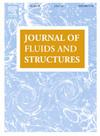一种用于弹性翼型后缘流固声模拟的插值-弹跳-浸没边界点阵玻尔兹曼方法
IF 3.4
2区 工程技术
Q1 ENGINEERING, MECHANICAL
引用次数: 0
摘要
本文采用点阵玻尔兹曼法(lattice Boltzmann method, LBM)对弹性后缘翼型在中高雷诺数下的流固声多物理场耦合进行了直接数值模拟。在处理移动边界时,提出了一种基于速度校正并结合插值回弹(IBB)的改进浸入边界法。该方法旨在通过高精度IBM在高雷诺数下进行声学计算,捕捉由固体振动引起的小压力扰动。通过悬臂梁和NACA0012翼型实例验证了该方法的有效性,验证了其模拟流固声耦合的能力。将不同弹性模量的弹性尾缘噪声与刚性尾缘噪声的结果进行对比,发现低频离散音调噪声有所降低,高频宽带噪声有所增加,证实了该方法在模拟弹性尾缘降噪中的有效性。利用DMD对声场结果进行频域分析,确认了小摄动波的物理性质,解释了降噪机理,验证了该方法模拟弹性尾缘小摄动波的准确性。本文章由计算机程序翻译,如有差异,请以英文原文为准。
An interpolation-bounce-immersed boundary lattice Boltzmann method for fluid-structure-acoustic simulation applied to elastic airfoil trailing edge
This paper presents a direct numerical simulation of fluid-structure-acoustic multi-physics coupling for an airfoil with an elastic trailing edge at the intermediate to high Reynolds numbers using the lattice Boltzmann method (LBM). When dealing with a moving boundary, a modified immersed boundary method (IBM) based on velocity correction and incorporating interpolated bounce back (IBB) is proposed. This method aims to capture the small pressure perturbations caused by solid vibrations through high-precision IBM for acoustic calculations at high Reynolds numbers. The method was validated by cantilever and NACA0012 airfoil cases, demonstrating its ability to simulate fluid-structure-acoustic coupling. A comparison between elastic trailing edge noise results with different elastic moduli and rigid trailing edge noise showed a decrease in low-frequency discrete tonal noise and an increase in high-frequency broadband noise, confirming the effectiveness of the method in simulating noise reduction with elastic trailing edges. Frequency domain analysis of the acoustic field results was conducted using DMD, confirming the physical nature of small perturbation waves, explaining the noise reduction mechanism, and validating the accuracy of the method in simulating small perturbation waves with elastic trailing edges.
求助全文
通过发布文献求助,成功后即可免费获取论文全文。
去求助
来源期刊

Journal of Fluids and Structures
工程技术-工程:机械
CiteScore
6.90
自引率
8.30%
发文量
173
审稿时长
65 days
期刊介绍:
The Journal of Fluids and Structures serves as a focal point and a forum for the exchange of ideas, for the many kinds of specialists and practitioners concerned with fluid–structure interactions and the dynamics of systems related thereto, in any field. One of its aims is to foster the cross–fertilization of ideas, methods and techniques in the various disciplines involved.
The journal publishes papers that present original and significant contributions on all aspects of the mechanical interactions between fluids and solids, regardless of scale.
 求助内容:
求助内容: 应助结果提醒方式:
应助结果提醒方式:


